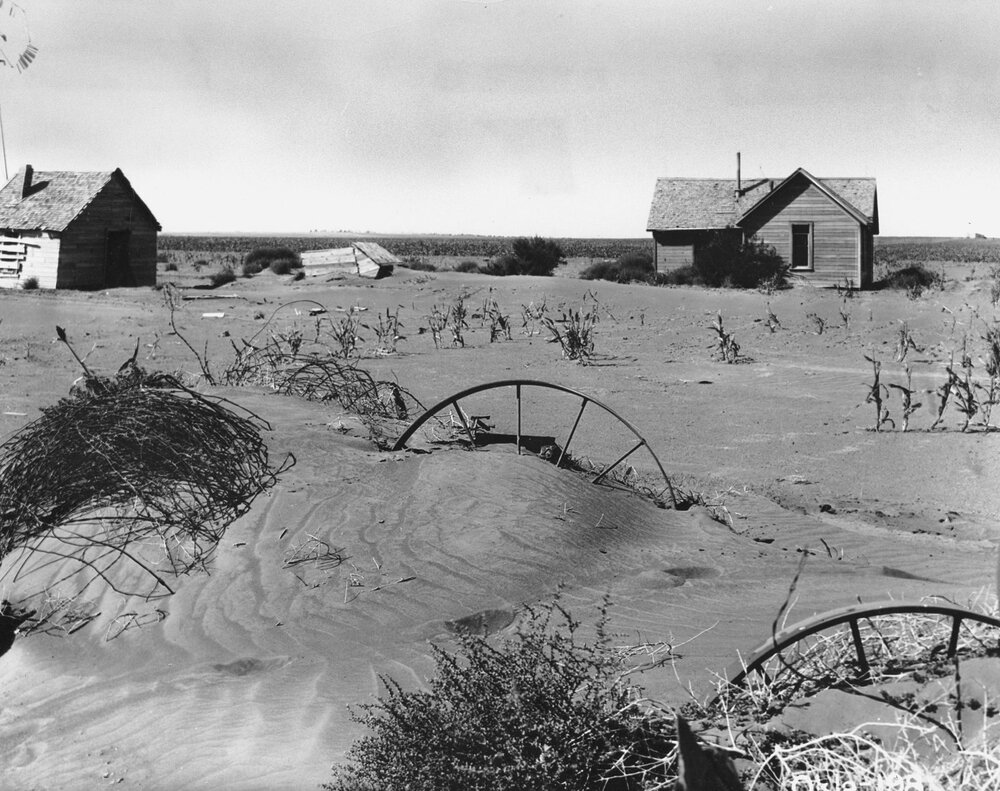I’m currently reading The Worst Hard Time by Timothy Egan. I’ve stopped after the first part to summarize the reading because it is an important example of market exuberance and investor bias through wheat farmers in the Southern Plains. Their fate is the Dust Bowl, a tragic disaster with a severity that is difficult to understand. That’s about as bad as bull market can end.
“Bull markets are born on pessimism, grown on skepticism, mature on optimism, and die on euphoria,” John Templeton
A Synopsis of the Southern Plains Bubble
After the Louisiana Purchase, Thomas Jefferson sent scouts across the newly acquired territory. Although the land expanded American’s growing empire, it was unclear at the time what laid beyond the Mississippi. One scout was sent to the Southwest where he discovered the Southern Plains. He reported back that the territory was like the Saharan Desert.
More of America’s landscape was discovered throughout the 19th century, fueled by the first Homestead Act and the Donation Land Claim Act of 1850 which focused on the Northwest Territories. The Homestead Act of 1862 allowed any American citizen to settle or farm up to 162 acres in the West and not long after, all the best farming land was settled.
The arid Southern Plains were not considered fit for farming. With average annual rain fall below 20 inches, farming was not option. Instead, cattle ranchers settled into Northern Texas, Oklahoma, Kansas and Nebraska. The red dirt was held together by grasses that covered the entire landscape, ideal for cattle grazing. Ranching did not thrive long-term, but short-term oriented fast money out of Europe helped drive the boom and bust cycles of cattle ranching until it was time for new era.
Dry farming was having success in pockets of the plains and soon thousands of Americans who missed the Homestead Act opportunity would flock to the Southern Plains.
Dryland farming consists of many techniques to grow crops in arid climates. It has evolved over the last century to incorporate crop rotation and minimal tilling but was popularized with winter wheat. This wheat is planted in the late fall and harvested in the summer. Soon the harsh winters of Northern Plains states led farmers south and many left with books in hand. Double your money in five years with How to Get Rich in the Great Plains or operate a profitable farm in the heat of Oklahoma with Campbell’s Soil Culture Manual.
“The only bargain left in America.”
After a few years of successful dryland farming, migrants flocked to the hot Plains. In 1908, 3,000 lots were sold in Boise City, Oklahoma alone. Brochures promoted the town’s growing businesses, bustling streets and green trees. Americans rode in by the hundreds to claim their new fate in the only free land in America, but upon arrival, they realized it was a lie. There were no trees and definitely no sprawling businesses. The lot sellers were convicted of fraud, but settlers still settled into Boise City for a chance at the American Dream.
“Die on Euphoria”
At the peak in 1914, 53,000 land claims were made in the Great Plains. In the Texas Panhandle, 30 towns alone were charted between 1910 and 1930. And it was all about money.
Two forces propelled the American wheat farmer in the early 20th century. First, in the 1830s it took 58 hours to plant and harvest an acre and by 1930 it took only three hours. This dramatic shift in productivity allowed farmers to produce more wheat at a lower marginal cost. As a result, between 1917 and 1919, the total acres of wheat increased from 45 million to 75 million.
Second, wheat prices were moving higher and fast. The price of a bushel of wheat in 1910 was $0.80, but by 1917 wheat farmers were collecting $2.00 a bushel at $0.35 cost per bushel. These margins and production levels were getting farmers rich in the Southern Plains.
Between 1924 and 1929, the number of acres converted from grassland to wheat grew to 2.5 million from 876,000 in the Texas Panhandle. By 1926, of the original 3 million-acre XIT cattle ranch, only 450,000 acres were unplowed.
Thousands more migrated for their chance at riches. Regret aversion goes two ways. An individual either regrets making an investment or regrets not making an investment (error of omission). The fear of missing out drove Americans looking for opportunities to the Southern Plains, often poor immigrants. The American government said this was the “last frontier of agriculture.”
From the Worst Hard Time, “Ida Watkins told everyone she made a profit of $75,000 on her two thousand acres of soil in 1926, bigger than the salary of Babe Ruth. The rains came steadily in the spring in those years, 1926 through 1929, and with the wet years, everyone forgot about the dry ones and said the weather had changed – permanently – for the better.”
But the weather did not change permanently.
The Dust Is Settled
By 1928, wheat prices had fallen sharply, from $2.00 back to $1.00 per bushel. At the same time, credit for farmers was flowing, yielding new vehicles, new tractors and new homes. Dryland farmers were moving out of their dugouts into real homes. Cash was needed to meet the debt payments, so farmers turned to the plow. By the 1930s, 5.2 million acres of grassland had been plowed for crops. In one Texas county, harvested production was up 100 percent at the end of the 1920s. The increased production soon led to piles of wheat on the ground and no one left to buy it. The same happened in the corn belt where farmers were paying storage facilities to take their corn.
The overproduction led to exposed land. Buffalo grass held together Southern Plain soil for millennia, and Cowboys warned farmers about plowing, but too much money was being minted. In the end, what was left was barren land, exposed to the high winds of the Southern Plains. Above-average rainfalls in the 1920s led many to believe the rain would stay, but the rains ended, and the Southern Plains did not have above-average rainfall again until 1941.
Wheat Farmer’s Tears Land in the Atlantic
A new opportunity, dryland farming, led migrants to the Southern Plains. They had missed the first land ownership offering and despite the skeptics, thousands relocated to grow wheat (regret aversion). Soon after plowing their newly acquired land, World War I began, increasing the demand for wheat and driving prices higher. Above-average rainfalls and technology advancements, wheat farmers plowed more and more land. “Rain follows the plow.” (Confirmation bias). The farmers decided not to save the money, in case their fortunes would turn, and spent on pianos, swimming pools, tractors, bigger homes and new cars. Their break-even point increased and when prices fell, they were cornered into even more production (status quo bias).
Unfortunately, the overproduction happened in the Southern Plains and the result was the Dust Bowl.
Directly from The Worst Hard Time: “On September 14, 1930, a windstorm kicked up dust out of southwest Kansas and tumbled toward Oklahoma…The weather bureau people in Lubbock didn’t know what to make of it or how to define it…The strange thing about it, the weather bureau observers said, was that it rolled, like a mobile hill of crud, and it was black. When it tumbled through, it carried static electricity, enough to short a car. And it hurt, like a swipe of coarse-grained sandpaper on the face.” This was the first black duster.
Over the 1930s, over 125 million acres of land would lose its topsoil and blow across the country. Americans who stayed in the Southern Plains shoveled dirt out of their houses daily, blown through every crack in the house. Ships as far as the Atlantic Ocean had black dirt accumulate on their decks. On one day alone -April 14, 1935- an estimated 3 million tons of topsoil blew from Oklahoma to the east coast.
But it was not just the topsoil that left the Southern Plains. For many Americans, their regret aversion bias changed from omission, the fear of missing out, to commission, the fear of buying the wrong investment. In all, 2.5 million Americans left the Southern Plains, the largest migration in history.




